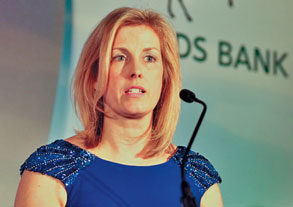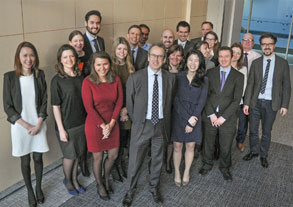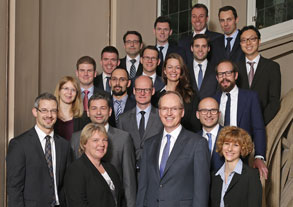

The past 12 months have been particularly testing for treasurers. Market and currency volatility and question marks about the overall cohesion of the European Union have brought much complexity to our day-to-day operations and have become something of a given.
From my vantage point as chair of the ACT’s Deals of the Year Awards judging panel, treasurers have responded to these exceptional challenges with ingenuity and great skill – a level of professionalism that we can all celebrate.
The call for entries for the Deals of the Year Awards for 2015 attracted submissions from a diverse sector base: retail, infrastructure, aviation, housing and education among them.
As judges, we were looking for achievements on timing, execution and demonstrations of strong market knowledge. And although we saw fewer entries across most categories than in previous years, we also saw treasurers and their teams innovating, working on more unusual deal structures and acting with dispatch when market changes demanded quick action.
Treasurers are enjoying greater interaction with, and respect from, boardrooms. It’s surely time to capitalise on that and begin to enjoy a wider profile and recognition
BAT, which of course goes to the market regularly and won in two categories – the larger of the two UK treasury teams of the year awards as well as the bonds above £500m category – pulled off a suite of challenging transactions working within a complex battery of regulation.
New Look, which won the smaller team of the year award as well as coming runner-up to BAT in the bonds above £500m category, provided a fascinating counterpoint to BAT with a refinancing and acquisition (all managed by the in-house treasury team). And while BAT and New Look’s transactions and activities were very different, the juxtaposition of the tobacco giant and the much smaller retailer prompted much debate around the judging table.
Chairing the judging of these awards is always rewarding. They provide an opportunity for us as a community to applaud the acumen, experience and hard work that goes into building a dynamic treasury team or executing a stand-out transaction.
Treasurers remain a reserved lot, but it’s my hope – and that of the ACT – that more individuals and teams will take on the task of promoting and celebrating the work that we do. And it’s surely incumbent on the organisations that we work for to do more to encourage and train their treasury professionals in this respect. Treasurers are enjoying greater interaction with, and respect from, boardrooms. It’s surely time to capitalise on that and begin to enjoy a wider profile and recognition.
I would like to extend my thanks to my fellow judges for their insights and for generously giving up their time to the Deals of the Year Awards judging process. Once again, we are indebted to Lloyds Bank, which continues to sponsor the awards. Our thanks, too, go to the ACT for continuing to promote this important programme of awards.
I hope you enjoy reading about our winners from 2015 and would encourage you to enter next year’s awards when nominations open later in 2016.
Lesley Flowerdew is group tax and treasury director at design, engineering and project management consultancy Atkins. She chairs the Deals of the Year Awards panel

The Treasurer’s 2015 Deals of the Year and Treasury Team of the Year Awards were judged by:
The Treasurer’s Deals of the Year and Treasury Team of the Year Awards provide recognition of, and applause for, the professionalism and skills that treasurers contribute to their organisations.
All kinds of deals are eligible for entry, regardless of their size or complexity. In judging the awards, the judges look at a range of criteria including: sound treasury management, innovative structures, ability to work with stakeholders and efficient pricing.
On occasion, we have situations where a judge’s company has been nominated for an award. In these cases, the judge concerned sits out the discussion.
It is not hard to identify risk in our current business environment: we can take our pick from the Greek crisis or identify wider volatility experienced in the eurozone within individual markets and across foreign exchange markets. Then there is broader geopolitical risk, emerging market turmoil, increased sensitivity around corporate reputation, erratic stock markets… you get the picture.
In the face of these risks, and in spite of the increased frequency with which they appear in the world’s media and on the corporate dashboard, treasury teams are instrumental in constructing the deals that will refinance, provide backing for IPOs or acquisitions, diversify their organisations’ funding structures and support complex mergers or acquisitions. All this and the day job, too.
On the following pages, you will find the narratives behind this year’s best-in-class – the winners of The Treasurer’s Deals of the Year Awards. There can be little doubt that the hard work that goes into designing and executing these diverse facilities and the wider support that treasurers provide for the business deserves our applause – and much wider recognition, too.
Liz Loxton, editor of The Treasurer
Awards reporting by Michelle Perry

Energy giant National Grid accessed the markets last September in a bid to diversify its funding sources, but in a rare move the corporate did so without risking any dilution to its shareholders, and raised debt financing at a lower cost than available in the traditional bond market.
The UK electricity and gas corporate took advantage of investors’ appetite for investment grade paper, after a quiet few months in the market, to raise £400m of convertible debt at a fixed rate of 0.9% to 2020.
The transaction resulted in National Grid North America Inc raising fixed-rate debt at an effective interest rate materially lower than conventional debt. It was the first time anyone has accessed the sterling convertible bond market with no equity dilution and no share price risk.
At the same time, the FTSE 100 corporate bought call options on its shares to offset the economic exposure from a potential exercise of the conversion rights embedded in the convertible. This innovative approach provided attractively priced funding from an additional source of liquidity for the group. As a result, National Grid secured good liquidity in line with its risk policy.
The deal was oversubscribed multiple times and ultimately upsized from £350m to £400m due to demand, which further highlights the deal’s success.
Credit Suisse was lead bank on the deal and had been working on the transaction with National Grid for some time to get it right. BNP and Morgan Stanley were joint bookrunners.
The transaction was all the more impressive for the fact that just two to three people out of a treasury team of around 12 worked on the deal
Malcolm Cooper, group treasurer at National Grid, said: “As a utility, we can sustain large amounts of debt; so, for us, pricing was critical. This was very attractive because it reduced the cost of debt.”
Since National Grid finalised its deal, three other large corporates across Europe have followed suit, copying the utility’s lead and benefiting from the path that National Grid took. The transaction was all the more impressive for the fact that just two to three people out of a treasury team of around 12 worked on the deal.
“We are very pleased with the outcome and grateful to the support we got from our lead banks. And, as people say, ‘imitation is the sincerest form of flattery’,” Cooper added.
The nominating bank called the deal “an innovative funding structure from a very professional treasury team”.
One of the bankers heavily involved in the deal said: “We really enjoyed working with National Grid because of their professionalism, expertise, good market judgement and their open attitude to this innovative debt financing. Working with the National Grid team, we were able to take advantage of the unique market opportunity and to secure an attractive funding advantage compared to straight debt, while broadening the investor base.”
Over the next few years, National Grid expects to raise, on average, around £2bn to £3bn of new long-term debt every year to finance expansion of its business and refinance maturing debt – the vast majority of which is raised in the capital markets.
Issuer: National Grid
Amount: £400m
Structure: Single tranche/convertible bond
Rating (at time of deal): Baa1 (Moody’s)/BBB+ (S&P and Fitch)
Currency and tenor: £/5yr
Interest rate: 0.9%
“The deal showed innovation and excellent execution.”
“It was a very good team, smoothly executed. It was that combination that stood out compared with other deals.”
Thames Water Utilities Ltd successfully secured investors in a complex deal to create a new company to deliver the £4.2bn Thames Tideway Tunnel (TTT), one of the biggest infrastructure projects in London.
The deal stood out as an innovative structure because of the ongoing challenges faced by the private sector in building infrastructure projects, and surpasses the scale of any single project undertaken in the UK water sector to date.
The cost of capital for the project came in at just 2.497%. It was considered to be a complicated deal for the critical underground construction project and compares well to more typical costs for the UK water sector of between 3.6% and 3.85%.
Establishing a separate infrastructure company significantly de-risked the transaction from Thames Water’s perspective. The structure not only shares the construction risk with private-sector investors, but it also reduces the impact on Thames Water’s household customer bills from the original estimate of £70-£80 a year – set four years ago – to £20-£25 a year.
The TTT requires around £3bn of debt to be raised during construction, which represents a significant portion of the debt issuance in the whole UK water sector.
The new company – owned by a consortium of international investors – will be an independent, regulated utility company established for the design, build, finance and delivery of the super sewer.
The cost of capital will be fixed for 15 years, covering the full construction period.
The backers behind Bazalgette Tunnel – named after Sir Joseph Bazalgette, the engineer behind London’s Victorian sewers – include insurer Allianz, Amber Infrastructure, Dalmore Capital and investment firm Dutch Infrastructure Fund.

British American Tobacco (BAT) returned to market in March last year in a refinancing initiative, but in a rare move the corporate undertook a four-tranche €3bn deal in a bid to maximise investor engagement.
In a single approach, the transaction was able to avoid cannibalisation of demand between tranches and achieved pricing that minimised the new issue concession.
Neil Wadey, BAT group treasurer, said: “Based on our cash-flow assumptions, we wanted to do a bigger transaction than we usually do. Based on demand, we realised a long tranche would be more attractive to investors – and it suited us.”
Although the official use of the proceeds was to be for general corporate purposes – including the financing of working capital and refinancing of bonds and commercial paper – the two large transactions coincided with two acquisitions by the tobacco giant last year.
Too many dismiss [leadership] by saying, ‘no one can call the market’, but having a strong sense that what is achievable is transient, is a core skill and BAT consistently does this; it asks the right question
BAT was then able to pay $4.7bn to subscribe to Reynolds American’s equity offering to maintain its pre-existing 42% stake. BAT also acquired the remaining 24.7% equity stake in its Brazilian operation Souza Cruz for around £2.3bn.
The company was able to manage its debt-maturity profile while adhering to strict internal treasury policies regarding concentration of maturity. The overall cost of funding was attractive in a historic context (with the 30-year tranche only paying 2%).

“Overall, it was an efficient process, as we expected, supported by our core issuing banks that provided us with good advice,” Wadey added.
The deal underlined the organisational efficiency of BAT, which meant that the tobacco company was able to minimise exposure to market risk at the same time as managing two separate bridge facilities.
The nominating bank said that strong leadership in deal timing and market judgement is an underrated skill in treasury.
“Too many dismiss it by saying, ‘no one can call the market’, but having a strong sense that what is achievable is transient, is a core skill and BAT consistently does this. It asks the right question – is there an opportunity that I can do today that I might not be able to do tomorrow?” the bank said.
Issuer: BAT
Amount: €3bn
Structure: Four-tranche public, senior facilities
Rating (at time of deal): A3/A- (Fitch, Moody’s and S&P)
Currency and tenor: €/4yr + 8.5yr + 12yr + 30yr
Interest rate: 0.375% for 4yr/0.875% for 8.5yr/1.250% for 12yr/2% for 30yr
“Often deals are overcomplicated and that can often come back to haunt deals further down the line. Sometimes simple is good.”
“This deal showed flawless execution and perfect timing. It is the model of a larger bond issuance.”
New Look completed one of the largest deals in the European sub-investment grade market in 2015, refinancing the group capital structure at the same time as selling the group to a new private equity owner, Brait.
The retail group successfully finalised an £800m M&A while simultaneously completing a £1.2bn high-yield bond refinancing at a time of market volatility and an overall challenging environment. The New Look transaction was executed in the early weeks of June against a backdrop of volatile markets driven by concerns relating to Grexit, as well as other negative macroeconomic factors.
The transaction consisted of three tranches of £700m senior secured notes at 6.5%, €415m denominated floating rate notes at Euribor +4.5% and £200m 8% senior unsecured notes. A new six-year revolving credit facility of £100m was also put in place to provide incremental liquidity.
The most significant benefit to New Look was the achievement of a lower cost of capital, enabling higher future cash-flow generation.
Fast execution capability and real-time structuring expertise meant New Look could lock in an attractive all-in funding cost and a diversified funding structure. The nominating bank said: “Outstanding work by the treasury team in guiding the board, CEO and CFO with real time and independent market assessment, and delivering in context of a very short time frame.”

London & Quadrant Housing Trust (L&Q), one of the UK’s leading housing associations, demonstrated how to complete a difficult sale in one of the UK’s most challenging sectors last October when it raised £250m via a bond issue.
L&Q, one of London’s largest residential developers, returned to the market in 2015 after a three-year hiatus with a 34-year benchmark deal, which priced at a coupon of 3.75%, and was significantly oversubscribed by investors.
In spite of market volatility as well as UK Chancellor George Osborne’s housing policy changes – announced in the Budget last spring – L&Q achieved an unparalleled spread, coupon and order book size with its deal, demonstrating investors’ support for the sector.
In spite of market volatility as well as George Osborne’s housing policy changes, L&Q achieved an unparalleled spread, coupon and order book size, demonstrating investors’ support for the sector
Osborne announced plans to reduce the household benefit cap from £26,000 to £23,000 a year, while housing benefit will be reviewed, both of which will impact significantly on L&Q’s customers.
Martin Watts, L&Q director of treasury, said: “We wanted to outline to our investor base that although we are in a challenging environment where government policy is influencing our business, we are prepared to face up to the challenges and have the desire and capabilities to achieve our objectives.”
The deal developed the company’s credit curve and was fundamentally critical to the implementation of L&Q’s group strategy, securing strategic financing that supports the housing association’s ambition to provide housing for families in London and the South East of England.
The opening level offered a high single-digits premium to L&Q’s outstanding 2040 notes and by having flexibility on tenor, the company was able to take advantage of a slight inversion at the longer end of the gilt curve, saving an additional 6bps.

Watts added: “In terms of market participation, it was clear from the transaction where it was priced that there was fantastic support from the investor base; that they valued the L&Q name. And in supporting our name, they have confidence in our ability to deliver and in the strength of our management.”
Given the exceptionally strong demand, syndicates were able to tighten guidance to G+135-140bps with a statement that bonds would price within that range. The majority of orders remained and pricing was set at the tight end of the range at G+135bps.
“The 10bps movement was the largest tightening in the sterling market since July and was testament to the strength of the credit and the excellent job by the L&Q presenting team during the roadshow,” the nominating bank said.
The borrower was last in the market in April 2012 with a 4.625% December 2033 bond.
Issuer: London & Quadrant Housing Trust
Amount: £250m
Structure: Senior secured bonds
Rating (at time of deal): A1/AA (Moody’s and S&P)
Currency and tenor: £/34yr
Interest rate: 3.75%
“The well-rated housing association sector has taken considerable advantage and this was an excellently placed, long-term issue leading the way in 2015.”
Property developer Hammerson issued its first sterling bond in nine years, which was all the more impressive in a volatile market.
The successful launch and pricing of the 10-year, £350m bond maturing in 2025 was priced at 173 basis points over the reference gilt and has an annual coupon of 3.5%. The issue was more than two times oversubscribed. Hammerson subsequently swapped the sterling bond nominal amount and coupon payments into euros, resulting in a net coupon cost to Hammerson of 2.5%.
The proceeds will be used to fund its recent €1.85bn acquisition of a distressed loan portfolio from Ireland’s National Asset Management Agency, as well as refinancing a forthcoming bond maturity.
At the time of issue, Timon Drakesmith, CFO of Hammerson, said: “This transaction is the first sterling bond issue by Hammerson for almost 10 years and represents a welcome return to a home-funding market. We are appreciative of the support shown by our key bond investors, and our relationship banks have assisted in swapping the coupon to a low 2.5% level in euros.”

Worldpay was catapulted into the FTSE 100 this year valuing the global payment processing group at around £4.8bn thanks to investor support for its flotation.
To achieve this end, the treasurer secured a £1.7bn bank facility to refinance existing indebtedness and establish the group’s new capital structure following the UK’s largest private equity (PE) initial public offering (IPO) to date. Prime Minister David Cameron called the listing “fantastic news”.
The £1.7bn facility was split across three facilities, including a £600m three-year loan, a £900m five-year loan and a £200m revolving credit facility with a syndicate of 18 international banks.
The deal was increased from its original terms reflecting the open and concise management communication, which led to strong demand.
The payment services management company was able to create a wide international banking group to support its global banking needs
Nigel Roberts, Worldpay treasurer, said: “It went extremely well. We were delighted with the outcome.”
Roberts said he wanted pure senior debt from a group of relationship banks, despite some banks offering alternative structures. The treasurer started the process in June last year with a group of four banks, all of which signed up for the highest level ticket – £150m. This was then expanded to other banks involved in the IPO process, which resulted in Worldpay launching with £1.2bn of the required £1.7bn, which “was a powerful starting point”.

Although Roberts used Lloyds to coordinate documentation, he said he was mindful of all the banks in the group and ensured he had direct relationships with all 18 banks.
The loan allowed the group to successfully transition from a leveraged debt structure to a corporate framework representing its new listed status. The facility allowed this to take place immediately at the point of IPO through a single facility agreement.
Following the IPO, Worldpay was able to partially refinance its £600m term loan (due in 2018) with a new €400m senior unsecured notes due 2022, issued by its wholly owned subsidiary Worldpay Finance plc.
Total demand for the transaction was in excess of £2bn from the banks invited, with the majority of banks choosing to participate at the top-tier commitment level.
The payment services management company was able to create a wide international banking group to support its global banking needs and worked under tight deadlines with a high degree of uncertainty due to equity market volatility.
Worldpay was sold by Royal Bank of Scotland five years ago for around £2bn. The company rejected a £6.6bn offer from France’s Ingenico to push ahead with the share offer to raise £890m.
Issuer: Worldpay
Amount: £1.7bn
Structure: Three senior unsecured facilities – £600m 3yr term loan, £900m 5yr term loan and a £200m revolving credit facility
Rating (at time of deal): Ba3 (Moody’s and S&P)
Currency and tenor: £/3yr + 5yr
Interest rate: 2.25% for 5yr RCF/1.75% for 3yr term loan
“This was a classic structure when a company comes out with an IPO in terms of stepping up its balance sheet.”
“This was the largest PE IPO in the UK last year, and allows the team to settle down and restructure the treasury function.”
Wolseley successfully completed a two-tranche facility last year, as it sought to remove a major refinancing hurdle in its debt-maturity profile, and to lengthen and diversify its funding sources. The deal, an £800m revolving credit facility (RCF) and an $800m US private placement (USPP) across a range of tenors from five to 12 years, required careful coordination across different stakeholders, geographies, asset classes and parties, as the company chose to execute in both the USPP and loan markets simultaneously.
The transactions also raised significant capital against a challenging credit backdrop in a quick time frame. Its treasury team took around just seven weeks from the selection of its six banks to completion.
The parallel running of the RCF refinancing with the issuing of a USPP delivered a full financing solution quickly and efficiently for Wolselely during strong market conditions, while also delivering a significant upfront ‘underwrite’ deal and strong competitive tension from the lead RCF/USPP banks.

FTSE 100 airline easyJet launched its debut issue last year with a $500m revolving credit facility (RCF) using a unique structure that contained few draw-stop events and avoided any financial covenants.
The deal was all the more impressive for one of the UK’s top public companies given its relatively small treasury team, led by group treasurer Mike Hirst, who, at the time of the deal, had been with the airline for less than a year.
Hirst and his team oversaw the facility’s design and leveraged key relationship banks in order to secure an efficient structure for the company and its lenders.
Despite it being a challenging sector, the transaction – which was oversubscribed – was uniquely crafted to support easyJet’s liquidity position and better manage the impact of downturns in business or temporary curtailment of activities. easyJet has a target minimum liquidity requirement of £4m per aircraft in the fleet.
Three may sound like a lot [of law firms] to have, but they all played their roles really well and that helped the deal to be a success
The facility’s structure avoided introducing covenants into the company’s operations by instead providing security over unencumbered aircraft, while retaining a corporate loan approach.
It was so carefully designed that the security only ‘bites’ when drawn and is based on complex valuations. From the outset, the aircraft valuations were agreed upon for the duration of the deal and in this way the facility contained barely any draw-stops, which is unusual in the market.
The transaction was two-pronged in its aim so that Hirst could create an international core banking group – which easyJet had not previously had – that would cover all the no-frills airline’s funding needs for the tenor of the deal.
As a result, easyJet created a new international banking group of 12 global banks, ensuring the airline has a strong and varied group of worldwide relationship banks for the future.
Hirst said: “This gave us a liquidity facility no matter what. There was a lot more to this than just a facility. This was a strategic deal to define our group of banks.”
Nominated for the awards by several of its banks, one bank described it as a clever way of taking advantage of the company’s balance sheet together with market-leading pricing. The same bank said the facility delivered “a first-class deal” for the airline and its shareholders.

Ultimately, the deal provides the company with financial flexibility and, importantly, it also provides a more appropriate funding mix to support the company’s capital expenditure and strategic development targets.
One nominating bank said: “Mike Hirst, who was the thought leader both in respect of the introduction of an RCF into easyJet’s structure and the deal itself, had been in the company for less than a year at execution, demonstrating his very rapid gaining of traction within the company and development of a strong depth of understanding of its needs.”
Hirst added that the three law firms involved in the deal contributed to its success thanks to their various legal specialisms.
“Three may sound like a lot [of law firms] to have, but they all played their roles really well and that helped the deal to be a success,” Hirst said.
easyJet is one of Europe’s leading airlines – operating over 600 routes across more than 30 countries with a fleet of 200-plus Airbus aircraft – and employs more than 8,000 people, which includes 2,000 pilots and 4,500 cabin crew. Last year, the airline carried more 60 million passengers.
Issuer: easyJet
Amount: $500m
Structure: Single tranche
Rating (at time of deal): Unrated
Currency and tenor: $/5yr + 1yr + 1yr
Interest rate: Undisclosed (but market-leading pricing)
“This was an unusual debut RCF for a long-established FTSE 100 company”

If you’re looking for an example of a team to hold up as the best in class in treasury, look no further than British American Tobacco’s (BAT’s) treasury team, this year’s winner of the UK Treasury Team of the Year award.
BAT, one of the world’s largest companies with a globally centralised treasury function, showed how to undertake several large-scale strategically critical deals skilfully, while playing a pivotal role in the successful conclusion of two major acquisitions last year, as well as overseeing a systems upgrade.
The team was nominated by several banks, all of which could not speak more highly of the treasury team. BAT’s nominating banks consider BAT’s treasury team members to be not only professional and talented, but also “great communicators”.
One of the nominating banks said the team had an “impressive track record of successfully combining and executing several M&A, DCM [debt capital market] and loan-market transactions”.
Treasury was closely involved in several complex M&A transactions, in particular, the £1.8bn public tender offer for 24.7% of Souza Cruz in Brazil, and a $4.7bn investment in Reynolds American in the US to support its acquisition of Lorillard.
BAT has an excellent track record of developing treasury professionals with a combination of technical qualifications and commercial experience. Neil Wadey, group treasurer, is a former ACT student of the year
Both transactions were notable for their scale and regulatory complexity, which in turn created a considerable challenge for treasury. The team had to execute concurrent funding and risk management exercises against an uncertain timeline and a volatile market backdrop.
BAT minimised the new issue concession it paid by pre-funding the Souza Cruz tender at the earliest possible opportunity with a four-tranche €3bn deal and then by executing its five-tranche $4.5bn trade shortly after regulatory approval was provided on the Reynolds/Lorillard tie-up. Their efficiency of execution meant they were less exposed to the credit spread widening seen later in the year.
The team was also able to secure strong support and competitive pricing from its banking group, demonstrating the value of its long-term relationships.
Glenn Forbes, a banker at Lloyds who worked with the BAT team on a number of recent transactions, said that in both cases of refinancing, the team had to manage a volatile backdrop with narrow windows of opportunity for best execution, which the team skilfully made happen. “Had they been unable to move at the earliest opportunity, pricing would have been very different from what they achieved,” Forbes said.

In the background to the refinancing exercises and funding of the acquisitions, the treasury team also oversaw the final stage of a SAP roll-out.
BAT is one of the UK’s most global companies, and as such the group consistently looks to develop optimal structures for the centralisation of treasury activities.
Last year, its treasury team finalised the last stages of a landmark SAP project – a fully integrated enterprise resource planning system with treasury management system, which is SWIFT-enabled and connected to external trading platforms. The arrangement supports end-to-end integrated treasury operations, including cash management, forecasting, risk management, dealing, payments and accounting.
The team also integrated a global treasury operations organisation embedded in a shared services centre to execute treasury activities globally from Japan and Australia to Russia and South Africa to Costa Rica. Treasurers around the world would concur that this in itself is no small feat – let alone negotiating the intricacies of it while accessing the market for refinancing and funding acquisitions.
Moreover, BAT has an excellent track record of developing treasury professionals with a combination of technical qualifications and commercial experience. Neil Wadey, group treasurer, is a former ACT student of the year. The group also has a well-established clear structure and support for team members to complete ACT qualifications.
“Long term, it has a fantastic reputation for developing people, setting the tone in treasury and in advancing in implementing best-in-class systems to maintain their position at the forefront,” added Forbes.
“BAT has got to have one of the best treasury teams. It is the leading edge; it is the team to look up to.”

The coveted award for UK Medium/Small Sized Business Treasury Team of the Year goes to New Look, which attracted praise for hard work and technical knowledge, successfully guiding the company’s board with real-time market assessment, and going on to deliver a successful deal in a tight time frame.
New Look’s treasury team secured one of the largest deals in the European sub-investment-grade market last year, when it locked in an attractive all-in funding cost and a diversified funding structure against a backdrop of market volatility.
The small New Look treasury team sealed both an £800m M&A acquisition by Brait and a £1.2bn refinancing between March and June last year to ensure a successful conclusion for existing and new shareholders. Also on the agenda was full refinancing of the balance sheet, transforming the company’s capital structure to ensure the future growth of the business.
“The treasury and finance team that delivered the successful completion of both the acquisition by Brait and refinancing demonstrated exceptional ability to deal with very technical issues across all facets of the transactions, while building strong, long-term relationships with the company’s advisers, which remain today,” said one of the judges.
The majority of the treasury team’s work was completed against a backdrop of market volatility and heightened uncertainty around stability in the Eurozone
New Look’s owners – private equity firms Apax Partners and Permira Advisers, together with Tom Singh and senior management – had been waiting for the right opportunity to exit the business. That opportunity arose last year, following the company’s improved performance over the previous 18 months. It was decided that New Look would prepare for an initial public offering (IPO) in the summer of 2015, but would also quietly explore the opportunity for a trade sale.
A small team began the multiple work-streams required to deliver a successful IPO, including corporate appointments, board meetings, engaging advisers and preparing accounting reports. Simultaneously, a smaller team within that main team began exploring options for a trade sale.
At the same time, the treasury team also had to secure post-IPO financing, moving the company balance sheet from a highly levered business at around 5.5x leverage down to below 2.5x leverage in line with a listed public company. The team managed to progress bank financing to the point where the company was ready to proceed early, allowing time to continue ongoing discussions with the potential buyer, Steve Humphreys, head of group treasury at New Look, explained.

In May, New Look announced a share sale and purchase agreement with Brait. However, in the lead-up to the announcement, the team also had to continue to work on all IPO streams, IPO refinancing negotiations with more than 10 core banks, as well as completing the year-end statutory accounts, annual report and negotiating a successful sale of the business to Brait.
Despite the huge achievement, in the background the team also had to start early discussions on what capital structure would be appropriate for the new owners. An opportunity arose to refinance the existing debt on the balance sheet of around £800m bonds and £370m PIK [payment-in-kind] loans, with a full cash pay bond refinancing of £1.2bn. As a result, the team achieved both a lower cost of debt and extended the group’s debt maturities from 2018 to 2022/23. In June, the project team completed a full refinancing of the £1.2bn of debt on New Look’s balance sheet.
It is also worth noting that the majority of the treasury team’s work was completed against a backdrop of market volatility and heightened uncertainty around stability in the eurozone due to the Greek debt default crisis.
“The team demonstrated exceptional ability to deal with technical issues across all facets of the transactions.”
“This happened faultlessly and on time, a true testament to the preparation, planning and management of the treasury and finance team.”

The treasury team at German pharmaceutical company Merck is named as this year’s European Team of the Year thanks to the treasury team’s unstinting efforts to help ensure the success of the $17bn acquisition of US life science company Sigma-Aldrich.
The team’s pivotal role in the acquisition of Sigma-Aldrich – creating one of the leaders in the $130bn global industry – began in 2014 and continued until the deal was passed by regulators late last year.
In September 2014, Merck’s treasury team, led by group treasurer Rando Bruns, arranged the largest corporate acquisition financing in Europe since the financial crisis in 2008. The team secured a $15.6bn dual-currency loan facility to finance the acquisition.
The transaction was favourable, as the banks provided financing on a ‘certain funds basis’ without any financial covenants and with limited restrictions. Merck’s team also negotiated long availability periods and maturities, which would safeguard the availability of the financing.

In March 2015, the next take-out measure followed with a $4bn US bond. During a four-day roadshow, the Merck treasury team met 20 of the largest US asset managers and held conference calls with around 60 asset managers. This allowed Merck to issue a five-tranched bond with maturities between two and 10 years. The order book peaked at around $7bn with more than 130 investors involved.
This was Merck’s inaugural US bond and it has allowed the corporate to enlarge its investor base with demand from domestic asset managers driving the transaction. Ultimately, US accounts took over 80% of the total offering.
The last and final deal took place in August with a €2.05bn bond. The transaction was carried out against the backdrop of the Greek euro crisis, meaning that its treasury team had to closely monitor the market in order to take advantage of the first available opportunity to announce the bond.
Due to our technical knowledge and abilities, as well as innovative systems, we are able to integrate Sigma-Aldrich as quickly as we are doing
Bruns said: “All these projects and achievements were accomplished by a centralised and relatively small group treasury unit, next to their day-to-day activities. We believe them to have shown excellent treasury-management skills in financing and risk management. Due to our technical knowledge and abilities, as well as innovative systems, we are able to integrate Sigma-Aldrich as quickly as we are doing.”
The deals contributed significantly to the overall strategic direction of the group. Moreover, across all transactions, the treasury team worked together with all 17 existing relationship banks. Eleven of them played an active role in one of the three transactions.

“The negotiation of the combined facility for the term and bridge financing ($15.6bn) with three banks within a very short time frame was of vital importance for the offer. It was also the goal to further strengthen the relationship to all the group’s relationship banks by fair distribution of fees to all banks, equal league table credits, and transparent communication about role and fees from the beginning on,” added Tim Nielsen, head of group treasury, capital markets at Merck.
Aside from the strategy to engage all 17 relationship banks, Merck’s team used the hybrid and the US market for the first time, and enlarged its investor base and geographic reach significantly.
Bruns added: “The relationship approach taken in the Sigma-Aldrich financing enabled us to further strengthen and leverage the excellent relationship Merck is having with its banks.”
The structure of the deals was strategically considered, as it was critical for Merck that the rating agencies granted a 50% equity credit, which underpinned Merck’s commitment to a strong investment grade rating.
“Merck has been a serial nominee and a respected previous winner. It is a high-quality team in a global business.”
Awards reporter Michelle Perry is a freelance business and finance journalist
